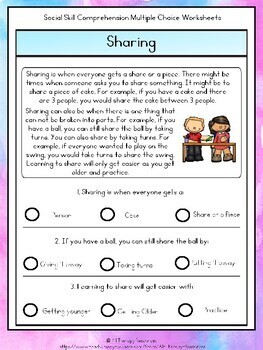

A second audio cue asking, “Do you have any good ideas?” was subsequently presented, and the option to insert a unique solution was presented. An audio cue asking, “What would you do?” was presented, and icons offering problem-solving solutions, such as requesting to go first, were provided. For example, participants were shown a scenario in which two children wanted a turn to go down a slide. In particular, social conflicts were presented to participants on a computer screen with choices of possible solutions and an option to insert an individualized solution. ( 2001), who used a web-based problem-solving program to teach typically developing children and children with ASD to select and develop appropriate solutions. One notable exception is a study conducted by Bernard-Optiz et al. In addition to the paucity of research on this topic within behavior analysis, there is limited research outside of the behavioral literature that has evaluated methods for teaching individuals with ASD to use problem-solving strategies for dealing with social conflicts.

The results of the study indicated that participants’ target behaviors improved during training, and follow-up performance in the natural environment improved compared to baseline. During follow-up, an audiocassette recorder was placed in the participants' shirt pockets to record their interactions during their work and evaluate generalization of responding to trained stimuli in the natural environment. Pictures of novel social situations (other than the target situation) were presented at the end of training sessions to assess generalization to untrained stimuli and only one of three participants demonstrated stimulus generalization. Participants were provided with seven rules or questions to ask themselves: (1) What is happening? (2) What are three behaviors I could emit? (3) What will be the outcome of each behavior? (4) Which is better? (5) Pick one (6) Emit the behavior and (7) How did I feel? Prompting, modeling, and praise were used to teach participants to use the seven rules/questions. During training, the researchers provided participants with a picture of themselves in a social situation (e.g., passing by a familiar customer at their workplace) and asked them how they would behave in the presented situation. In addition, the results showed that participants resolved untrained social conflicts in the absence of the worksheet during natural environment probe sessions.Īlthough the population of ASD has not been studied in previous behavioral research on using problem-solving strategies to deal with social conflicts, a study conducted by Park and Gaylord-Ross ( 1989) used behavioral procedures to teach individuals with intellectual disabilities precurrent behaviors including rules, self-questioning, and self-prompting to solve problems they encountered at work, including social initiations, mumbling, and conversation expansions and terminations. The results showed that using the worksheet was successful in bringing about a solution to social conflicts occurring in the natural environment. Three male participants with ASD were taught to use a worksheet as a problem-solving tool using multiple exemplar training, error correction, rules, and reinforcement. This study used a nonconcurrent multiple baseline across participants design to assess the efficacy of a problem-solving training and generalization of problem solving to naturally occurring untrained social conflicts.


Individuals with autism spectrum disorder (ASD) often have difficulty resolving social conflicts, yet this skill is important for successful social interaction, maintenance of relationships, and functional integration into society. Resolving social conflicts is a complex skill that involves consideration of the group when selecting conflict solutions.


 0 kommentar(er)
0 kommentar(er)
